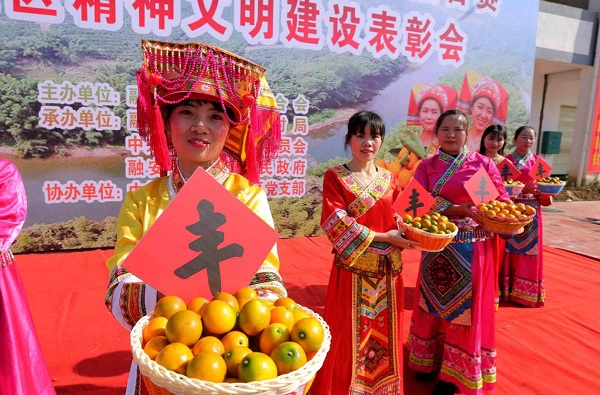Kumquats help drive village economy
Updated: 2020-09-12

Women belonging to local minority ethnic groups showcase Rong'an kumquat in November. QIN QINGHE/FOR CHINA DAILY
Yield improves
Chen said with the development of the local farmer field schools, more and more farmers improved their technical knowledge in agriculture. The yield of kumquat has also improved significantly, with a higher proportion of high-quality fruits.
"The output per 140 hectares among trainees has increased by 500 kg, an increase of 40 percent. Their direct profit has reached 44.5 yuan per hectare, compared with non-trainees' profit of 21.7 yuan, meaning trainees earned 105.3 percent more," Chen said.
By the end of 2019, Rong'an county had grown 11,133 hectares of kumquat and harvested 150,000 tons of the "golden orange", with an output value of 1.5 billion yuan. A slightly more than 54 percent of the county's poverty-stricken families, or 8,781 people, planted 2,342 hectares of kumquat.
The success of the farmer field schools in Rong'an qualified them to be included among the "100 Best Cases" in the Global Solicitation and Challenge Prize on Best Poverty Reduction Practices, where officials from the World Bank, the International Poverty Reduction Center in China, the International Fund for Agricultural Development, the Food and Agriculture Organization of the United Nations and many more organizations discussed and chose the best poverty reduction case studies.
The popularity of FFS in Rong'an has won the county a lot of admirers home and abroad. Indonesia is one of them.
Sukajaya village in Indonesia's West Java province is home to more than 6,000 people, and the villagers rely primarily on rice farming for their livelihood.
But after attending a two-week farmer field school in Rong'an, Sukajaya village chief Deden Gunaefi decided to encourage the villagers to go beyond rice farming. They planted fruits and vegetables, wove baskets, and started developing their village into an agritourism site.
"What I learned from the workshop in China is that you can alleviate poverty by developing agriculture and rural industries," Gunaefi said.
He said that since he began implementing new projects in late 2019, village residents have reported their incomes have increased-they can now sell more products through village-owned enterprises.
Gunaefi is one of 26 Indonesian village officials who was sent to Guangxi last September to learn how to lift the standard of living in their villages. Eight of those officials were village chiefs.
He said he attended discussions on using farm technology to boost farm production, mariculture-the specialized cultivation of fish or other marine life for food-and rural entrepreneurship.
"It is an honor to have visited China, because of the lessons I learned and how I implemented them in my village," said Gunaefi, who is now more aware of how agriculture and rural industries can alleviate poverty. Indeed, he is thankful that innovation has transformed farming activities locally.



